Brisbane Grammar School
Brisbane Grammar School (BGS) is an independent, non-denominational, day and boarding school for boys, located in Spring Hill, an inner suburb of Brisbane, Queensland, Australia. It is the oldest secondary boys school in Brisbane.[1] Some of the Brisbane Grammar School Buildings are listed on the Queensland Heritage Register.[3]
| Brisbane Grammar School | |
|---|---|
 | |
| Location | |
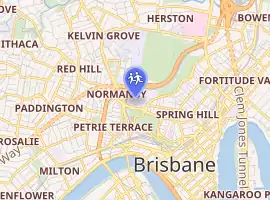
| |
| , Queensland Australia | |
| Coordinates | 27°27′33″S 153°1′0″E |
| Information | |
| Type | Independent, day & boarding |
| Motto | Latin: Nil Sine Labore (Nothing Without Labour) |
| Denomination | Non-denominational |
| Established | 1868 |
| Employees | ~120[1] |
| Grades | 5–12 |
| Gender | Boys |
| Enrolment | ~1,700 (2016[1]) |
| Colour(s) | Sporting: Oxford Blue and Cambridge Blue Academic: red and gold[2] |
| Website | www.brisbanegrammar.com |
Established in 1868 under the Grammar Schools Act that was passed by the Government of Queensland in 1860, the school has a non-selective enrolment policy and currently caters for approximately 1500 students from Years 5 to 12,[1] including around 100 boarders.[4]
Brisbane Grammar is affiliated with the Australian Boarding Schools Association (ABSA),[4] the Association of Heads of Independent Schools of Australia (AHISA),[5] Independent Schools Queensland (ISQ),[6] and is a founding member of the Great Public Schools' Association Inc (GPS).[7]
2018 marked the 150th anniversary of the founding of Brisbane Grammar School.
History
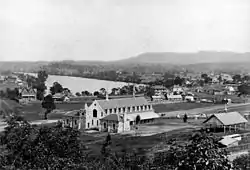
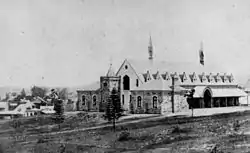
Brisbane Grammar School was founded in 1868 under the Grammar Schools Act, which had been passed by the Queensland Government in 1860. It was the second school established under this act in Queensland, with the first being Ipswich Grammar School.
The original school, designed by Benjamin Backhouse, was on a site in Roma Street in Brisbane City, approximately opposite modern Herschel Street. HRH Prince Alfred, Duke of Edinburgh (1844–1900), second son of Queen Victoria, laid the foundation stone at the site on 21 February 1868. The school opened in February 1869, with ninety-four students and four masters, under the leadership of headmaster Thomas Harlin.[8] In 1881, the school was moved a few hundred metres away to its current site on Gregory Terrace in Spring Hill to make way for the Roma Street Railway Station, which still stands today.
It has been referred to as the "Eton of Australia".[9]
Following the opening of the boarding house in 1886, science laboratories were constructed in 1912.
On 14 August 1916, the Queensland Governor, Sir Hamilton Goold-Adams unveiled a war memorial with the names of 600 students who had enlisted.[10] In 1921, Brigadier General Lachlan Chisholm Wilson, a former pupil, presented a field gun to the school, an Austrian-made 10.4 cm Feldkanone M. 15, which had been taken from the Ottoman Army by the Australian Light Horse at the Capture of Jenin in 1918.[11]
A new library and assembly hall were constructed in 1969 as a celebration of the school's centenary.
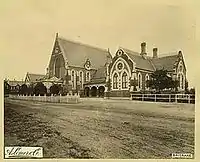
During the mid-1990s, the school commenced work on the off-campus Northgate ovals, which now consist of six fields that are used for cricket, rugby union and soccer fixtures. The Indoor Sports Centre was completed in 2000, and the old gymnasium was later renovated to become the new Centre for Art.
In 2002, the school underwent a major redevelopment with the construction of a new Middle School, which had its first intake of grade 6 and 7 students in 2003. This Middle School consists of a large block of multi-purpose classrooms, functioning as a complete school in itself, with its own teachers and independent timetables. Grade 6 and 7 students spend most of their time in the Middle School, although they do use the facilities of the "Upper School" for such activities as physical education and assemblies. In 2014, Year 5 was added to the Middle School with 100 new students enrolled.[12]
Headmasters

| Period | Details |
|---|---|
| 1869–1876 | Thomas Harlin |
| 1876–1909 | Reginald Heber Roe |
| 1909–1927 | F. S. N. Bousfield |
| 1928–1939 | S. Stephenson |
| 1940–1947 | G. Carson Cooling, Old Boy of Brisbane Grammar School |
| 1948–1952 | H. R. Pigott |
| 1953–1956 | A. E. McLucas |
| 1956–1963 | H. R. Newell, Old Boy of Brisbane Grammar School |
| 1964–1989 | Dr. Maxwell Howell AM |
| 1990–2005 | Dr. Peter Lennox |
| 2006–2013 | Brian Short, Old Boy of Brisbane Grammar School. |
| 2014– | Anthony Micallef |
Academics
Curriculum
Brisbane Grammar School offers education from years 5 through to 12. The academic programme is tailored to suit the needs of its students. In recent years, around 95% of graduating students have received a first-round offer to a tertiary institution. The school offers mainstream subjects including English, Mathematics (A, B and C), Science (Physics, Chemistry, Biology and Earth Science), History (Modern and Ancient), Geography, Economics, Health and Physical Education, Music, Technology Studies, Art, Drama and Languages other than English (French, German, Japanese, Chinese, Latin).
In addition, the school focuses on a specific academic scope of learning aimed at educating life-skills required in the future. As of late, it has introduced updated technology to assist the students learning from school as well as home. In addition to this currently all students from grades 8–12 each have a Toshiba Tablet PC with a majority of the school's curriculum installed. For the Middle School, Brisbane Grammar School offers the mainstream subjects (with Spanish and Latin being offered as Languages other than English), as well as laptop facilities.
Recent results
In recent years, 95% of graduating students have received a first-round offer to a tertiary institution.[13] In 2006, the school had its second best results since the introduction of the OP system, claiming 49 OP1s. The combined percentage, of OP 1–2 was 30.45% of the school, population which far exceeded the state's average of 5.2%. 68.31% of the students received between and OP1 and an OP7 (the state percentage being 25.4%). 91.8% of the cohort received an OP between 1 and 13. The median OP score was OP5.[14]
With respect to the school's 2008 results, more than one in four students (26.4%) of the cohort achieved an OP 1 or 2. The OP 1–7 result of 63.2% (State 27.4%) was well above the historical average and fourth best result ever and the OP 1–13 result was at 90.1% (State 60.9%) and was the third best result in the school's history.[15]
In 2012, students achieved, in the School's history, the highest percentage of OP1s. A total of 51 students attained an OP1, equating to 20.6% of the cohort. OP1-7 results were also the second best recorded in the School's history (68.5%), while the OP1-13 (93.1%) and OP 1–15 (97%) results, like the OP1 percentages, were also historical records for the School.[16]
Extracurricular activities
Cultural activities
Students are able to participate in a wide range of musical groups, established by former Directors of Music, John Broughton,[17] and Bruce May,[18] including two orchestras, five concert bands, three stage bands, eight string ensembles, five choirs, and an array of other instrumental ensembles, including three percussion ensembles. John Callaghan was the driving force behind establishing most of the bands.[18] Student-led ensembles feature in concerts every year. Furthermore, each year the BGS Music Department performs an event known as the Grammar Community in Concert, typically at the Queensland Conservatorium of Music. This event brings together members from across the BGS Community, including the BGS Community Choir, incorporating parents, teachers, and friends. The school also has a thriving Drama program, largely established by former Drama Master, Brian Cannon,[19] presenting a range of plays and musicals. In addition, opportunities in debating and public speaking are offered, with the school participating in Queensland Debating Union and Greater Public Schools annual competitions. Additionally, Brisbane Grammar School has recently revamped its participation in enterprise education groups. With the newly reformed Economics and Enterprise Club, students are gaining exciting experiences through external competitions such as YAA, Ecoman and ABW. An array of other special-interest groups exist, including those which focus on Chess, Astronomy, Aviation, Christianity, Environmental aid, and Community Service.
Sport
The school offers a range of mainstream sporting activities, including cross country, track and field, rugby, football, basketball, tennis, cricket, gymnastics, swimming, rowing, sailing, chess and volleyball within the GPS association of schools, as well as many others such as water polo, fencing, Australian rules football and tae kwon-do.
GPS membership
Brisbane Grammar School is a member of the Great Public Schools Association of Queensland Inc. (GPS). The school's membership enables its students to participate in sporting competitions as well as engage in endeavours such as Debating and musical events. Most competitions are played out on Saturdays at any of the schools' sporting facilities. The main campus comprises four playing fields in addition to eight tennis courts. Many fixtures, including Cricket, Rugby and Football, are conducted at the Northgate Campus. Sailing is run on Sundays at RQYS, Manly, and the GPS championship is held at the end of the season. The school has had long standing success in Water Polo, winning the competition for 12 of the last 13 years.
Recent achievements
In 2006, BGS's Senior A debating team achieved 2nd in the GPS competition after losing only one debate in the last round to GPS champions St. Joseph's College, Gregory Terrace. Also in 2006, the School won seven GPS titles (GPS Cross Country, GPS Volleyball, First VI Volleyball, First XI Soccer, GPS Sailing, GPS Gymnastics and GPS Chess), five more titles than any other GPS school.
In March 2007, the school secured the O'Connor Cup by winning the 1st VIII race at the annual Brisbane GPS Head of the River. Furthermore, the 2007 Senior A Debating Team became the champions of the QDU state competition, with a team member making the Australian side.
In 2008, the Senior A team won the GPS premiership undefeated and 2 team members achieved selection in the QLD team.[20]
Following the 2008 victory in debating, the 2009 BGS Senior A Team was even more successful, winning both the QDU and GPS premierships convincingly beating all opponents. Members of the team Daniel Gibbons, Andrew Justo and Marc Harris were all selected for the State Team, and the BGS Year 12 group of 2009 was, up to that time, the most successful debating cohort in the school's history.
However, in 2010, the BGS Senior A Team were undefeated in both GPS and QDU competitions to take out premierships in both. 3 members of the team were selected for the QLD State team, and proceeded to win the National Competition, completing the trifecta of debating championships.[21] In 2011, BGS won both the QDU and GPS Senior A season undefeated beating All Hallows School in the QDU final to become State Champions.
In 2010, BGS tied with St Joseph's College, Gregory Terrace to win its 8th consecutive GPS Volleyball Premiership. Terrace beat BGS, in a fullhouse at Terrace only to lose to TGS in the second last round handing BGS a tied premiership. In 2011, Brisbane Grammar completed the season undefeated, beating Gregory Terrace in straight sets at a packed Indoor Sports Centre.
2012 saw BGS, represented by Nicholas Salmon, Matthew Hales, Philip Gracen and captained by Benjamin Gibbons, win the QDU debating Senior A, defeating Churchie in a unanimous decision, the first of its kind in the competition. BGS also won volleyball for its 10th straight volleyball victory. In a final like situation at Ross Oval, the BGS rugby first XV defeated Nudgee College to secure an outright premiership in rugby for the first time since 1972.
2013 carried over the success of 2012 with an 11th straight premiership in GPS Volleyball, the first Cricket premiership in 30 years as well as a premiership and state championship to the flagship sailors. 2013 also saw 7 GPS premierships – more than any other GPS school. The School won Volleyball, First XI Cricket, Sailing, Chess, Senior A Debating, Tennis and Gymnastics.[22] The Grammar Vocal Ensemble also achieved a perfect score (100/100) at a Choral Eisteddfod
2017 Saw the return of the Swimming GPS crown to BGS for the first time in 40 years.
2018 Saw BGS go back to back in the GPS swimming.
Campus
Indoor Sports Centre
The Indoor Sports Centre was officially opened by the Governor of Queensland, Major General Peter Arnison on 3 March 2000. The centre, which is situated on the main campus, is home to a multi-purpose double Basketball court sports hall (which can also accommodate 3 Volleyball courts, 6 Badminton courts, 12 fencing pistes as well as Futsal), an Aquatic Centre with a 10-lane, 25m heated swimming pool, a Gymnasium featuring a deep foam pit, parallel bars and rings and a spectator area with seating for 150 people during sporting events, an indoor Cricket net, as well as a weights room and theory rooms and amenities. This sports centre has hosted local and international sporting teams, such as the Queensland Reds, Australian Wallabies, Brisbane Broncos, New Zealand All Blacks, Australian cricket team, United States Swimming squad and the English Rugby team.
Northgate playing fields
Work commenced on the Northgate Playing Fields in the mid-1990s, which now have six ovals, accommodating Cricket, Rugby union, Soccer and Australian Rules Football fixtures. The fields are also used during the school week, especially for winter activities training sessions. Canteen facilities are provided on game days. Adjacent to the main oval is a small stadium which caters for seating for one half of the field, which also contains a dining area. The playing fields were used by the Australian Cricket Team prior to the 2006/2007 Ashes campaign, where they trained with the school's First XI.[23]
Normanby playing fields
Normanby, adjacent to the school grounds, harbours tennis courts and minor track and field facilities. Students visit this facility for PE lessons as well as sports training sessions. It is separated from the main campus by a public footbridge. These ovals are being threatened by the Legacy Way Tunnel that have taken away the oval, leaving only tennis courts.
Auditoriums and theatres
The school has 6 major auditoriums and a theatre: The Centenary Hall, The Great Hall, The Lilley Centre Forum, The Music Auditorium, The Amphitheatre, The Gallery and The Theatre.
Centenary Hall accommodates the entire senior school (8–12) student body for weekly assemblies, when The Gallery above is opened up to the Hall. The hall is also used for other events such as breakfasts, music concerts, debates and year-level tests. The Gallery above the hall can accommodate 2-year groups for lectures and information sessions.
The Great Hall is one of the school's most historic buildings. The walls have various honour-boards commemorating academic, sporting and cultural achievements, as well as honouring the names of those who have served in wars. The stage is overlooked by a 10*3-metre stain-glass window, with Queen Victoria and her knights of the realm as a central feature. The hall provides venue for Form Year Assemblies, Public speaking, debating and music performances. It is also used for dinner parties (such as the Old-Boys Association's reunions or the 'Mothers of Past Student'’ gatherings) and weddings for old-boys.
The Forum can seat around 150–200 people and is used for collaborative learning exercises, usually housing all students in a subject or 3–4 classes. When using the extra seating available, a whole 250 student cohort can be housed.
The Music Auditorium, established during the tenure of Bruce May as Director of Music, is a venue used to highlight the school's large music program. During the year a varied program of choral, concert and stage band and orchestral concerts take place. Many groups rehearse here weekly. Percussion equipment is able to fit in the hall.
The Drama Theatre, established under the tenure of Brian Cannon as Drama Master, can seat approximately 300 for theatrical productions. The school holds a Junior School Play, a Senior School Play and a Middle School Production (Play or Musical) every year. It is equipped with sound and lighting equipment, including audio and lighting boards operated by students, a Green Room, and technical storage space. The Centenary Hall for many years was the venue for theatre productions under Director, Brian Cannon.[19]
Moogerah Outdoor Education Centre
Brisbane Grammar School's off-campus centre at Pepperina Hill, near Lake Moogerah, was opened in 1976 and is named the Moogerah Outdoor Education Centre (colloquially referred to as Moogerah). The school sends each form class from grades 8, 9 and 10 out to the campus to strengthen intra-class relationships and morale, as well as develop team-working and leadership skills. Class, "Form Seniors" also attend the camp to build the relationship between the senior, and younger students. The five-day programme includes such activities as rock-climbing, bushwalking, orienteering, canoeing, and a camp-out in the bush at the foot of a mountain. Year 5, 6 and 7 students also visit the campsite, but for a shorter duration – one, two and three days respectively.
The centre is also used for various other school activities: Writer's Camps, Composers' Camps, Scientist-In-Residence Camps, sport training, ISCF Christian Camps, Astronomy & sky viewings and fieldwork in senior courses. The rowers utilise the camp's boatshed on the lake's edge for training.
The Lilley Centre
The most recent construction project of the school is a centre located on the College Road side of the main campus (named after Premier and Chairman of the Board of Trustees Sir Charles Lilley), and houses several classrooms equipped with learning technologies, a library, a lecture theatre (called 'The Forum') and a seniors' study room. The centre was officially opened on 26 February 2010 by former Premier of Queensland, Anna Bligh.
School uniform and colours
The School has adopted two sets of colours. The first was introduced by Thomas Harlin, Headmaster 1869–1876. They are red and gold and are now associated with academia. Reginald Heber Roe, Headmaster 1876–1909, introduced the sporting colours of Oxford and Cambridge Blue which are now seen as the main representative colours of the school. They still hold a particularly special relationship with sporting activities, represented by various school chants and war cries that mention the Light Dark Blue.
Recent incidents
Pedophile compensation controversy
In 2003, the school was involved in controversy when it attempted to recover damages from its insurer following students' claims that they had been sexually abused by Kevin Lynch, school counsellor between the 1976 and 1988.[24][25]
Some 70 former students sued the school, alleging Lynch sexually abused them during counselling sessions. Rejecting out-of-court settlements, some of the victims claimed compensation in the Supreme Court of Queensland. Two former students had allegedly lodged complaints about Lynch's conduct with then headmaster of the school, Maxwell Howell, in the early 1980s and the issue was quietly investigated. However Grammar was unaware the details of the investigation had to be passed on to its insurer.[24] For failing to notify its insurer of the complaints made of Lynch, the school thus became liable for A$1.17 million in legal fees and compensation.[24]
Lynch was charged in January 1997 over the abuses perpetrated at both St Paul's School (where he was subsequently employed) and Brisbane Grammar. Lynch committed suicide on 23 January 1997, the day after being charged.[26][27]
Fumes exposure incident
On 14 July 2010, 120 students were exposed to a chemical solvent being used in school construction works. Many of these students had been exposed for less than 20 minutes. 6 ambulance crews were dispatched to the school, where 35 students experienced sore eyes and throats as well as minor breathing difficulties. Of the students affected, 2 were hospitalised.[28]
Notable alumni
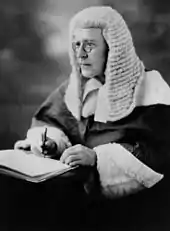
Politics
- Thomas Joseph Byrnes, former Premier of Queensland
- Frederick W. Paterson, a Rhodes Scholar and the only member of a Communist party ever to be elected to a parliament anywhere in Australia.
- Ian Macfarlane, Liberal National Federal Cabinet Minister
- Tom Burns, former Labor Party National President and Deputy Premier of Queensland
- Drew Hutton, co-founder of the Australian Greens, university lecturer, and social and environmental activist
- Sir James Killen AC KCMG, Minister for Defence and Federal Member for Moreton
Law and the judiciary
- Justice Ian Callinan, Justice of the High Court of Australia
- Justice Sir Charles Powers, Justice of the High Court of Australia
- Justice John Logan RFD, Judge of the Federal Court of Australia and President of the Defence Force Discipline Appeal Tribunal
- Max Julius, a noted Barrister and Communist[29]
- Peter Douglas Channell (1947–1993), a notable solicitor involved in the union movement in Queensland during the 1980/90s, president of the QLD Law Society 1988, legal advisor to the commission of inquiry during the Fitzgerald Inquiry, employed Peter Beattie as a solicitor at his firm Peter Channell & Associates
- Sir Arnold Lucas Bennett, a noted barrister and president of the Bar Association of Queensland (1957–1959)[30]
- Henry George Fryberg was a Justice of the Supreme Court of Queensland
Journalism
- Malcolm Farr, Canberra-based political journalist and commentator
- Michael Ware, CNN war correspondent and Time magazine journalist
Military and public service
- Sir Charles Spry, Director-General of the Australian Security Intelligence Organisation
- Major General John Pearn, Surgeon General of the Australian Defence Force[31]
- Commander Eric Feldt OBE RAN, Head of the Coastwatchers WWII[32]
- Brigadier General Lachlan Chisholm Wilson, commander of the Australian Light Horse in the First World War.[11]
The arts
- William Baylebridge, writer and poet
- Robert Davidson, composer, artistic director of Topology
- Robin Dods, architect
- Robert Forster, musician, singer-songwriter and founder of The Go-Betweens
- Jack Lindsay, Marxist author and poet
- J J Hilder, painter
- Leonard Shillam, sculptor [33]
- David Malouf, internationally acclaimed author [34]
- Brad Shepherd, member of seminal Australian bands The Fun Things, The Hitmen and The Hoodoo Gurus
- Ian Haug and John Collins of the band Powderfinger
- Murray Shepherd, member of seminal Australian bands The Fun Things, The Screaming Tribesmen and The Four Horsemen.
- Ian Fraser, singer of seminal Brisbane band Dementia 13 and Australian punk band Nunbait
- Spencer Howson, radio presenter
- Stephen Vagg, writer, author of All My Friends Are Leaving Brisbane (2007)
- Adam Zwar, actor and creator of award-winning television shows Wilfred and Lowdown
- Stephen Lance, award-winning director
- Christopher Wrench, organist[35][36]
- David Logan, author, historian, Artistic Director of Cabaret Puppet Theatre[37][38]
- Philip Edmiston, Artistic Director, Queensland Marionette Theatre and Theatrestrings[39]
- Ray Chen, violinist
- Hanbyul (Jason) Jang, member of K-pop boy band Led Apple
- Brett Williams, lead guitarist, backing vocalist with the band Choirboys who had hits such as Run To Paradise, Boys Will Be Boys, Struggletown, Rendezvous, Empire.
Science and academia
- Jock R. Anderson, agricultural economist at the World Bank and emeritus professor at the University of New England
- John Graeme Balsillie, inventor, communications engineer, business proprietor who oversighted establishment of Australia's coastal radio network
- Bob Bryan, geologist and businessman[40]
- Wilton Wood Russell Love, prominent Brisbane doctor and one of the foundation members for the Senate of the University of Queensland 1910-1916 [41][42]
- Alexander Marks, physician and military officer
- Errol Solomon Meyers, prominent Brisbane doctor and one of the founding fathers of the University of Queensland School of Medicine.
- Donald Nickin, chemical engineer and professors, Dux of his final year at the school [43]
- Cameron Bell, endocrinologist and Senior Lecturer, Medicine - Northern Clinical School, University of Sydney [44]
Business
- Tom Strachan, head of AWX
Sport
- Dick Marks - Wallaby and National Coaching Director
- Trent Baker, pitcher and outfielder for the Cleveland Indians and Brisbane Bandits baseball teams
- Mitchell Chapman, New South Wales Waratahs player
- Samuel Conrad, Australian eight Olympic rower
- Ben Cutting, cricket, Queensland Bulls, Australia, Brisbane Heat
- Luke DeVere, professional footballer, former QAS, AIS and current Brisbane Roar and Socceroo centre back
- Ben Dunk, cricket, Queensland Bulls, Hobart Hurricanes, Tasmania Tigers
- Roy Emerson, tennis player, won 12 Grand Slam singles titles and 16 Grand Slam doubles titles
- Francis Gailey, Australian/American freestyle swimmer
- Julian Gardner, Rugby, Wallaby & Italy
- Matthew Hammelmann- AFL Footballer
- Lee Holdsworth, V8 Supercar driver
- Toby Jenkins, Olympic water polo player 2004
- Dick Johnson, V8 Supercar legend
- Tom Lawton, former Wallabies captain
- Rob Lawton, rugby, Wallaby prop
- Cameron Lillicrap, rugby, Wallaby prop
- Joel Macdonald- AFL Footballer
- Alan Marshal, cricket, Queensland and Surrey County Cricket Club
- Bob McCowan, Wallaby captain 1899
- Andy McIntyre, rugby, Wallaby prop
- Matt McKay, professional footballer, captain of the Brisbane Roar FC and current Socceroo midfielder
- Edgar Moon, tennis player, won 1930 Australian Open men's single title, 1932 men's doubles title, 1929 and 1934 mixed doubles titles
- Stephen Moore, Wallaby since 2005 and former captain
- Frank Nicholson, Wallaby captain 1904
- Otto Nothling, one of only two Australian Cricket/Rugby Union players
- David Ogilvie, Australian test cricketer 1977–78
- Richard Powell, Australian Olympic rower
- Darryn Purcell, Australian rower
- Sir Charles Powers, Queensland Cricket captain
- Matt Renshaw, Cricket, Queensland Bulls, Australia
- Bill Ross, rugby, Wallaby hooker
- Pud Thurlow, Australian cricketer
- Keith Winning, rugby, Wallaby captain
- Greg Martin, rugby, Wallaby fullback
- David Nucifora, rugby, Wallaby hooker
Rhodes Scholars
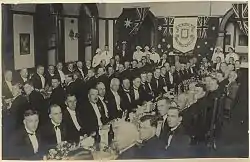
| Year of election[45][46] | Name[45][46] |
|---|---|
| 1904 | Arthur S. Roe |
| 1905 | Norman Leslie |
| 1908 | Stanley Castlehow |
| 1909 | Leonard G Brown |
| 1911 | Harold K. Denham |
| 1914 | Allan W.L. Row |
| 1915 | John N. Radcliffe |
| 1918 | Frederick W. Paterson |
| 1919 | Victor Grenning |
| 1922 | Tom Lawton |
| 1927 | Franz Konrad Saddler Hirschfeld |
| 1928 | John H. Lavery |
| 1930 | Cecil E. Kerr |
| 1939 | James K. Newman |
| 1958 | Thomas Baxter |
| 1960 | Clive P. Hildebrand |
| 1967 | John M. Fenwick |
| 1978 | Peter J. Wetherall |
| 1981 | Donald Markwell |
| 1982 | David M. Rose |
| 1991 | Craig Arnott |
| 1992 | Daniel V. Botsman |
| 2006 | Nicholas I. Luke |
| 2007 | Ryan A. Goss |
| 2020 | Nicholas Salmon[47] |
See also
- List of schools in Queensland
- List of boarding schools
References
- "2009 Annual Report" (PDF). Staff & Students. Brisbane Grammar School. Archived from the original (PDF) on 27 June 2011. Retrieved 26 June 2011.
- Brisbane Grammar School – Grammar History Archived 21 August 2011 at the Wayback Machine
- "Brisbane Grammar School (entry 600124)". Queensland Heritage Register. Queensland Heritage Council. Retrieved 1 August 2014.
- "Brisbane Grammar School". Schools. Australian Boarding Schools' Association. Archived from the original on 17 November 2007. Retrieved 27 December 2007.
- "AHISA Schools". Queensland. Association of Heads of Independent Schools of Australia. November 2007. Archived from the original on 2 November 2007. Retrieved 26 December 2007.
- "Brisbane Grammar, School". School Search. Independent Schools Queensland. Archived from the original on 27 November 2012. Retrieved 27 December 2007.
- "GPS Schools". Sport and Music. Brisbane State High School. Archived from the original on 31 August 2007. Retrieved 27 December 2007.
- "Grammar History". Brisbane Grammar School. Retrieved 17 August 2019.
- "On This Day | A State of War". A State of War | State Library of Queensland. Archived from the original on 25 June 2018. Retrieved 24 June 2018.
- "BRISBANE GRAMMAR SCHOOL WAR MEMORIAL". The Brisbane Courier. National Library of Australia. 11 August 1916. p. 6. Retrieved 11 April 2014.
- "Brisbane Grammar School WWI War Trophy". www.qldwarmemorials.com.au. The State of Queensland (Department of Environment and Science). 16 September 2015. Retrieved 11 January 2021.
- "Middle School". Brisbane Grammar School. Archived from the original on 6 May 2014. Retrieved 6 May 2014.
- Academic notes Archived 9 January 2006 at the Wayback Machine Official BGS website. Retrieved 7 January 2006; Report detailing academic results of the 2004 Senior cohort Official BGS website. Retrieved 7 January 2006.
- "Archived copy". Archived from the original on 26 December 2013. Retrieved 4 December 2013.CS1 maint: archived copy as title (link) {date=December 2013}
- Primrose, H., Light Blue Dark Blue, Brisbane, Brisbane Grammar School, p.236 ISBN 978 0 9593 287 6 9
- Primrose, H., Light Blue Dark Blue, p.236
- Primrose, H., Light Blue Dark Blue, p.253
- Boys Grammar Debaters Selected For State Team Official BGS Website Retrieved 3 November 2008
- "Brisbane Grammar School – Debating Trifecta". Archived from the original on 7 December 2010. Retrieved 27 March 2011.
- GPS
- "Cricket Australia > Inside Cricket > CA Centre of Excellence > Structure & Vision". Archived from the original on 27 February 2011.
- David Murray, School pays sex victims Archived 26 October 2009 at the Wayback Machine, Courier Mail, 5 November 2006
- Board of Enquiry report Archived 16 May 2006 at the Wayback Machine, Anglican Diocese of Brisbane, 22 April 2003
- Courier Mail Archived 26 October 2009 at the Wayback Machine
- Survivor Link
- "Nearly 200 exposed to solvent at Brisbane Grammar School in suburban Spring Hill" The Australian
- McGuire, John, 'Julius, Max Nordau (1916–1963)' Archived 15 August 2014 at the Wayback Machine, Australian Dictionary of Biography, National Centre of Biography, Australian National University, accessed 9 September 2012
- Demack, Alan. Australian Dictionary of Biography. Canberra: National Centre of Biography, Australian National University. Archived from the original on 20 December 2016.
- Patron – Major General J. Pearn, AM, RFD Archived 21 March 2012 at the Wayback Machine
- Brisbane Grammar School Magazine 1913
- https://trove.nla.gov.au/people/643261
- https://www.penguin.com.au/authors/david-malouf
- Primrose, H., Light Blue Dark Blue, p.263
- https://bach-cantatas.com/Bio/Wrench-Christopher.htm
- Cabaret Puppet Theatre - http://www.cabaretpuppettheatre.com/442509168 - David Logan, Artistic Director
- National Library of Australia - David Logan - https://catalogue.nla.gov.au/Search/Home?lookfor=author:%22Logan%2C%20David%2C%201960-%22&iknowwhatimean=1
- http://www.cabaretpuppettheatre.com/442285209 - Edmiston Collection
- "2009 Inductee: Bob Bryan, AM". Queensland Business Leaders Hall of Fame. State Library of Queensland. Archived from the original on 14 March 2018. Retrieved 14 March 2018.
- Leggett, C. A. C., "Love, Wilton Wood Russell (1861–1933)", Australian Dictionary of Biography, National Centre of Biography, Australian National University, retrieved 1 April 2020
- McConnel, Katie; Rogers, Jill (19 October 2016). ""To Sir with Love - The Doctor Wilton Wood Russell Love Album" - Dr Love, Dr Borivjoj Franko-Filipasic poster". www.ogh.qut.edu.au. Retrieved 1 April 2020.
- "Innovative engineer". The Courier Mail. November 3, 2007. 3 November 2007.
- https://www.sydney.edu.au/medicine-health/about/our-people/academic-staff/cameron-bell.html
- "Queensland Rhodes Scholars" (doc). Rhodes Scholarship. University of Queensland. Archived from the original on 12 September 2007. Retrieved 7 February 2008.
- "BGS History" (PDF). BGS History. BGS. Retrieved 7 July 2010.
- "Nicholas Salmon is Queensland's 2020 Rhodes Scholar". QUT News. Queensland University of Technology. Retrieved 22 August 2020.
Further reading
- Primrose, H. (2019). Light Blue Dark Blue, 150 years of Learning and Leadership at Brisbane Grammar School, Brisbane, Brisbane Grammar School, ISBN 978 0 95932 87 6 9
- Stephenson, S. (1923). Annals of the Brisbane Grammar School 1869–1922 / compiled by Stuart Stephenson. Brisbane: Government Printer
- Willey, Keith; Brisbane Grammar School (1968), The first hundred years : the story of Brisbane Grammar School, 1868–1968, Brisbane Grammar School ; Melbourne : Macmillan of Australia, retrieved 30 November 2016